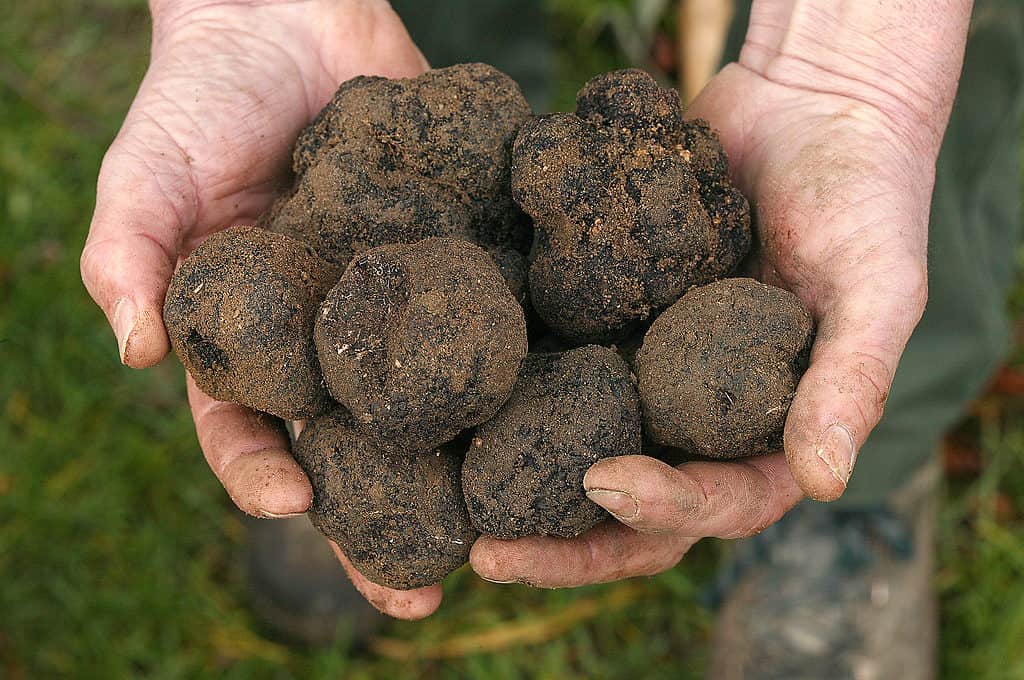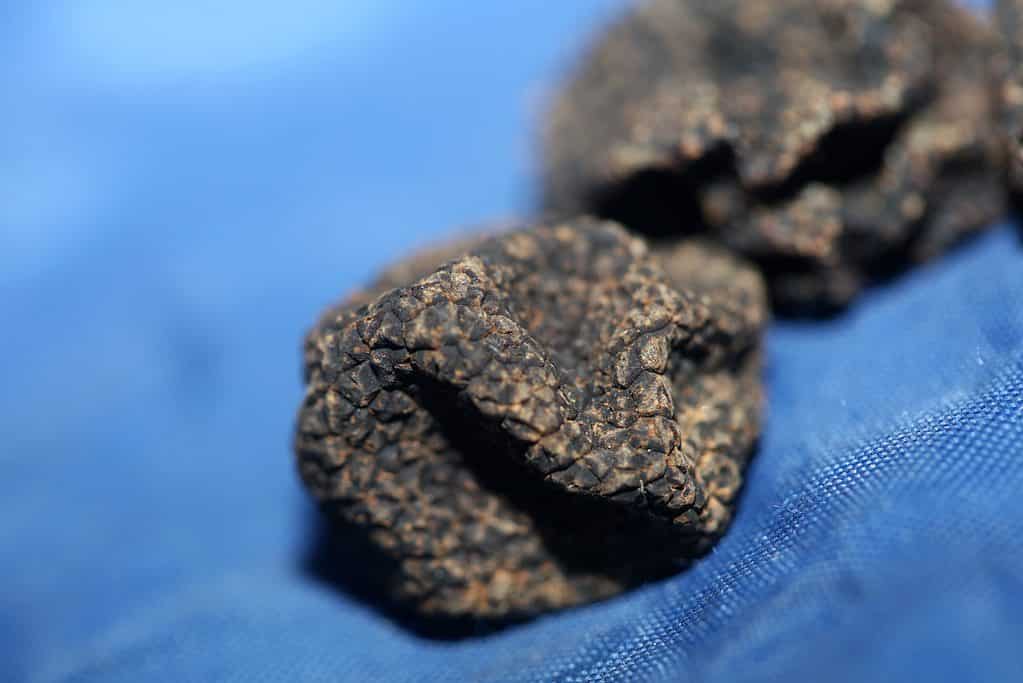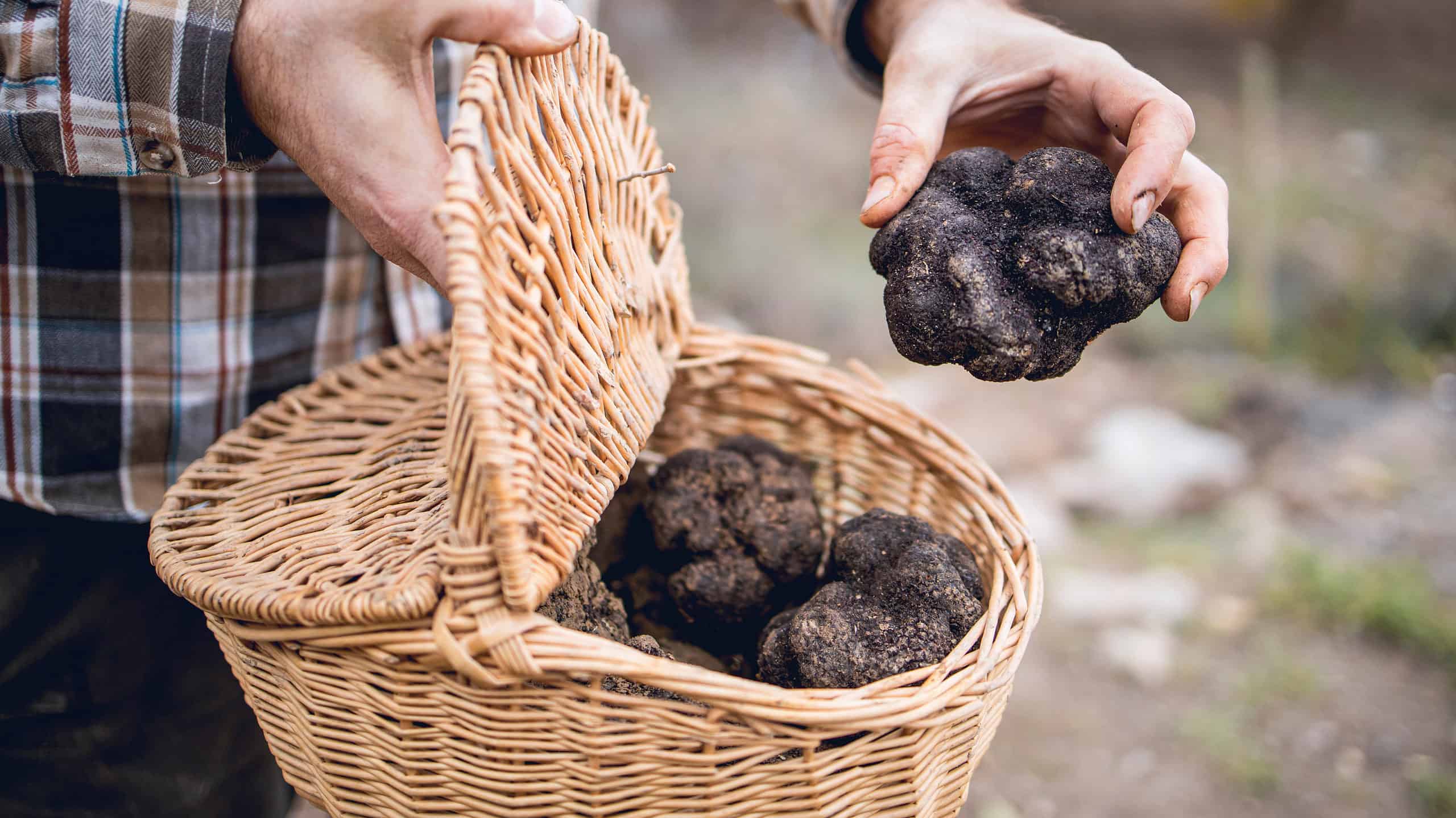Are you familiar with truffle mushrooms? Technically, a truffle is not a mushroom at all. Truffle mushrooms grow below the ground, while mushroom species grow above the soil. Truffles are still fungi, but they thrive in different climates and also grow in different places. Truffles are actually mostly tubers – like potatoes and carrots. There are a variety of truffle species, but most of them are in the Tuber sp. For example, the black truffle (the most sought-after truffle) is a Tuber melanosporum, while the summer truffle is a Tuber aestivum. There are a few exceptions – the Oregon black truffle (Leucangium carthusianum) is not a tuber at all, but a kind of fungus called “ascomycete fungus”. Regardless, it’s quite the treat. Today, we’ll be looking into how to find this delightful little fungi. So, where do truffles grow? How do I find truffles? We’re about to find out!
Where do Truffles Grow?

French black truffle,
Tuber melanosporum, is one of the most prized truffles in the world.
©slowmotiongli/Shutterstock.com
Truffles grow all over the world, but their presence is famous in European countries. France and Italy are especially famous for truffles, but many species grow all over Europe. Additionally, many more truffles are growing in North America now. This is thanks, in part, to new truffle farms working to grow truffles. However, it isn’t all the work of dedicated farmers. In Oregon, there are four known species that grow wild. There are also truffles in China, both growing wild and being cultivated on farms. These are Chinese truffles (Tuber indicum), and they have a lighter aroma and flavor than other European varieties. We’ve included a table of a few species of truffles and where they grow. Keep in mind that this table is not all-inclusive. There are over 140 known species of truffles around the world.
| Truffle Variety | Where It Grows |
|---|---|
| Black Truffle (Tuber melanosporum) | France, Italy, Spain |
| Burgundy Truffle (Tuber uncinatum) | Europe |
| Oregon Black Truffle (Leucangium carthusianum) | Oregon, Washington, Northern California |
| Bianchetto Truffle (Tuber borchii) | Italy |
| Pecan Truffle (Tuber lyonii) | North America |
| Chinese Truffle/Asian Black Truffle (Tuber indicum) | China |
| White Truffle (Tuber magnatum) | Italy, Southern Europe |
| Summer Truffle (Tuber aestivum) | Europe |
| Kalahari Truffle (Kalaharituber pfeilii) | Botswana, Namibia Kalahari Desert |
| Oregon Spring White Truffle (Tuber gibbosum) | Oregon, Northern California, British Columbia |
Truffle Hunting Conditions

France and Italy are especially famous for truffles, but many species grow all over Europe.
©iStock.com/vainillaychile
There are a variety of factors you have to consider when going to hunt for truffles. We’re going to cover a few details that will be imperative for success on your search for these delightful treasures. The first, and most obvious, is to always look where truffles actually grow. In the United States, that means favoring more western states, such as California, Oregon, Texas, Washington, Idaho, and Oklahoma. All of these states have a good climate for truffle growth. Next, we must learn about the types of places where these fungi like to grow.
Trees
Truffles look for specific hosts, which means not all areas are ideal for finding them. Truffles engage in a symbiotic relationship with their host trees. For this reason, trees play a huge role in truffle growth, and there are trees that truffles prefer. In general, oak trees are a great place to start. Oak trees provide plenty of nutrients and shade to this fungi, and if truffles are present, they will be close to the base of the tree. Here are some other trees that play good hosts to truffles.
- Beech
- Pine
- Birch
- Fir
- Hickory
- Eucalyptus
- Hazelnut
In the Pacific Northwest, Douglas fir trees are a great place to look for truffles.
Weather
Weather is a huge factor in truffle growth. This fungi needs a warm climate with moist soil. The ideal time to look for truffles is 10-14 days after a warm, heavy rain. This is, perhaps, one of the reasons why the Pacific Northwest is such a hotspot for truffle hunting. Rainfall is imperative for the growth of these fungi.
Season
Truffles, like most other fungi, have a specific season of growth. In the Pacific Northwest, this season runs from about June to September. However, there are spring and fall truffles that grow outside of this season. In Europe, the season varies more widely. For white and burgundy truffles, the season runs from September to December. For winter black truffles, foragers are on the lookout from December to early March. Bianchetti truffles grow from February to March. Summer black and white truffles have a season that runs from May to August.
How to Find Truffles

Dogs can be trained to sniff out truffles.
©slowmotiongli/Shutterstock.com
Now that we know more about this underground delicacy, we can focus on finding it. Traditionally, expert foragers will use the help of pigs or trained dogs to help them uproot truffles. Don’t worry, you can still hunt for them without the help of such a companion. First, you’ll need a few tools. You’ll want to bring a rake, trowel, and paper bag on your foraging expedition. The rake and trowel will help you unearth the truffles, and paper bags will help you store and transport them safely.
Next, go to a forest with the right trees and climate for truffle hunting. Once you’ve found a good spot, the search begins. Truffles are hard to find for a number of reasons, but there are a couple of visual cues you could use to assist your search. For example, many forest critters eat truffles. Approach the base of a likely tree and look for holes dug by these animals. Once you’ve found a likely spot, it’s time to use your tools.
You’ll want to carefully rake the leaves from the base of the tree before you begin. Then, use your trowel to gently dig holes around the base of the tree. These holes should be about 2-4 inches in depth. This part of the process requires time and care. If truffles are present, you won’t want to damage them. Look for bulbous growths with a warty texture. The color of truffles varies, but aim for colors like white, brown, black, and red. These delicacies will be anywhere from one to six inches in diameter and will usually have a deep, earthy smell. Dust off your discoveries and store them in your paper bags.
Properly Identifying Truffles

You can see the warty texture on this black summer truffle.
©BakalaeroZz Photography/Shutterstock.com
Before you eat your bounty, you’ll want to make sure you have foraged the right thing. There are no known poisonous truffles and very few lookalikes, but it is important to be cautious. Many species of mushrooms start their journey underground and in similarly bulbous shapes. For example, Amanita varieties often have underground “eggs” that sometimes resemble white truffles. Let’s go over a few details that will help you tell the difference.
| Name | Appearance | Texture |
|---|---|---|
| Truffle | Bulbous and warty, interior is marbled in color | Firm and brittle |
| Amanita sp. | Bulbous and egg-like. | Squishy or spongy |
It will also help you to get a mushroom and truffle identification guide. There are several books and online resources that will help you determine what you’ve found. When in doubt, ask an expert. Some poisonous mushrooms won’t just make you sick – they can have lasting impacts on your body and organs. Always tread on the side of caution when searching for edible fungi.
Summary
We’ll finish out by breaking down truffle hunting into very simple steps. Use the rest of the guide above to help supplement this information when you go hunting.
- Always search for truffles in warm, moist weather, especially a week after heavy rains.
- Go to forests rich with symbiotic trees, such as oak and Douglas fir.
- Bring a rake, trowel, and paper bags with you.
- Search at the base of host trees, looking for signs of rodent presence.
- Gently dig your holes at a depth of 2-4 inches.
- Carefully remove soil and look for truffle presence.
- Store found truffles in paper bags to transport them and control moisture levels.
- Confirm the species of truffle before ingesting.
- Enjoy!
The information presented on or through the Website is made available solely for general informational purposes. We do not warrant the accuracy, completeness, or usefulness of this information. Any reliance you place on such information is strictly at your own risk. We disclaim all liability and responsibility arising from any reliance placed on such materials by you or any other visitor to the Website, or by anyone who may be informed of any of its contents. None of the statements or claims on the Website should be taken as medical advice, health advice, or as confirmation that a plant, fungus, or other item is safe for consumption or will provide any health benefits. Anyone considering the health benefits of particular plant, fungus, or other item should first consult with a doctor or other medical professional. The statements made within this Website have not been evaluated by the Food and Drug Administration. These statements are not intended to diagnose, treat, cure or prevent any disease.
Thank you for reading! Have some feedback for us? Contact the AZ Animals editorial team.








